Last time, we explored the upper floor of the baroque 19th century palace that holds the Natural History Museum of Vienna. It’s time to descend the marble staircase into the past and take our journey through deep time, from the distant precambrian days to the Holocene. Maybe we’ll even meet some dinosaurs along the way, who knows? I hadn’t done any research beforehand, so I visited the museum with very limited knowledge and not much in the way of expectations. I was ready to be surprised.

As the tour through time begins, we start with two or three halls dedicated to geology. Turns out the Precambrian age is a bit short on animal fossils. As the scientific disclipine that birthed palaeontology, I, of course, owe geology my respect. However, beyond the rather superficial enjoyment of seeing something pretty and shiny, I must admit that my capacity to enjoy minerals in cabinets is limited, no doubt due to my lack of expertise in the field. But I wouldn’t have a natural history museum without them.

I’m very good at identifying rocks, I’ll have you know. Yup. These are definitely rocks.

Oh good, an animal. Dunkleosteus is one of the superstars of the prehistoric world with its instantly recognizable head. No word on whether this is a cast or the real deal, though the fact that it’s exposed makes me suspect the former. It’s cool anyway. The poster that accompanies it in the background is a bit kitschy, as overdramatic Dunk reconstuctions are wont to be. I always prefer a reconstruction that makes it more like a fish and less like a guillotine submarine.
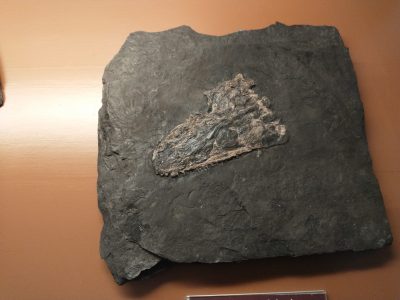
The skull of a mesosaur. Absolutely tiny. I bet it would have been cute in real life.
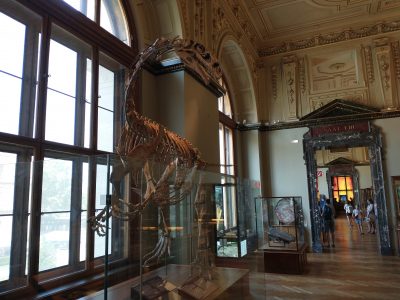
Let’s get some big guns in. The first mesozoic hall has Plateosaurus, one of the most famous European dinosaurs, as its focal point. I’m not a huge fan of the glass barrier, though of course one cannot argue with its necessity. What I do like is the fact that it’s been put on a little elevated pedestal, allowing the dinosaur to tower over the guests that much more dramatically.

The signage is super helpful here. Even though, unlike, say, Naturalis, the museum doesn’t show the difference visually, this plaque does tell you what bits are real and what bits are either reconstructed 3D prints of damaged or disarticulated bones (in green) or from other specimens (in orange). Oertijdmuseum Boxtel did something similar with their composite sauropod. I think every museum displaying mounted skeletons should strive to have something like this. For that matter, so should the rest of this museum.

Next to the Triassic animal is a Late Cretaceous one. I was worried this single Mesozoic hall was going to be all the dinosaurs we were going to get, but I needn’t have worried. Lesser-known chasmosaurs are always nice to see, especially when they’re, let’s face it, a lot cooler looking than plain old Triceratops. That said, the name of this one escapes me.
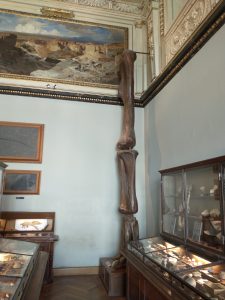
Here to show off the sheer side of the sauropod is a single brachiosaur leg, reaching almost to the incredibly ornate ceiling. It’s an effective way to sell the size of such a stupendous animal within the confines of a limited space. Meanwhile, the cabinets are full of fossils, all mesozoic and mostly of fish, invertebrates and small reptiles.

Meanwhile, along the top of the walls are all these paintings by commissioned artists. Most of them are of landscapes, depicting either the badlands of Europe, America and Asia that these fossils are retrieved from, or imagined landscapes of the Mesozoic world. Rarely do these depict actual animals, though there is the odd gem of vintage palaeoart among these. Not in the dinosaur hall, though.

Some dinosaur material. This belongs to Struthiosaurus, an ankylosaur found in Austria. Dinosaur finds are rare in Austria, especially compared to Germany and Switzerland, so it’s good to find some material here.
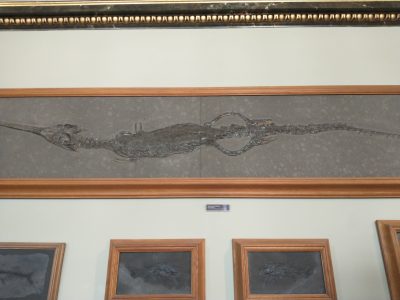
A thalattosuchian. I think the genus name given was “Steneosaurus“, a wastebasket taxon.

I’m not sure which specimen of Archaeopteryx this is. The Wikipedia article on notable Archaeoperyx specimens does not include a Vienna specimen, so this might be a cast of the Berlin urvogel. I’m willing to be corrected here.

A great variety of ammonites. I’m thinking Marie Hubrecht must have visited this place, as she reconstructed all of these in one of her collages.

Cenozoic now. Here’s a cool model Gastornis.

And a bulky cast of a deinothere. Are we done with dinosaurs already?

Nope. Turns out the biggest hall on this floor is dedicated to dinosaurs! There’s three mounted skeletons on the elevated plateau in the middle (all, I assume, casts): An Iguanodon, an Allosaurus and a Diplodocus. The Iguanodon is mounted in the traditional Belgian way, so we’re looking not so much at an accurate representation of an extinct animal but at a historic reconstruction of one (though, broken tail notwithstanding, at least this is a pose that an Iguanodon might have concievably adopted). This one brought back delightful memories of that time we went to Brussels when I was a kid. Over there, the famously fragile iguanodont skeletons are all behind glass, while this cast is out in the open.

A major problem with the mounted dinosaurs andotherprehistoric animals in this hall is that the signs don’t always tell you which mounts are casts and which are, at least partially, real. In the case of this Protoceratops, which is safely behind glass, I would hazard a guess at it being real.


Sea monsters adorn the walls. I assume everything not behind glass to be a cast.

Allosaurus also takes a starring role, another commonly reproduced cast. It seems to be based on an A. fragilis rather than the several near-complete specimens of A. jimmadseni dug up by colleagues from nearby Switzerland. Good to have a big theropod in the spotlight that isn’t T. rex.

The animatronic Allosaurus next to the skeletal one is the only non-skeleton on the plateau. It seems to be based on the Walking With Dinosaurs Allosaurus, which can also be seen on the posters on the windows. Maybe there was some collaboration going on around 1999. WWD’s influential red-horned, tiger striped Allosaurus was always one of my favourite depictions of this animal. Unfortunately, the robot suffers from bunny hands, which the animated version didn’t.

A really likeable piece of mammoth palaeoart. The name of the artist was too high up to read.

Here’s that well known model of a shaggy, feathered Deinonychus you see in many modern books. The signs give information on the connection between birds and dinosaurs. There’s also a Psittacosaurus skeleton, which seems a bit random in this context. Psittacosaurus being a common dinosaur, I think the skeleton might be real.

I love this Pteranodon (Geosternbergia?) skeleton. It really shows off the incredible anatomy of a large pterosaur. Again, no idea if it’s real (Pteranodon is common as far as pterosaurs go, but pterosaurs are rare in general).

Here’s the obligatory Triceratops and T. rex cameo to please the crowd.

As you might have guessed, the Diplodocus is one of the many casts of the original Diplodocus carnigeii that can be found all over the world. You might know Dippy from the NHM in London. Our friend Ilja wrote a book about these casts which I’m ashamed to say I’ve yet to read, but here it is if you’re interested. Interestingly, no skull is known for Diplodocus proper; all diplodocid skulls found have been re-interpreted as either Galeamopus (as in this case), Kaatedocus, or, worst of all, diplodocinae indet. Like the Iguanodon, this cast is as much a historical artifact as it is a palaeontological one.

More moas. Art, ornaments and details wherever you look. It’s almost too much to take in. The hall is cramped and full of stuff everywhere you look, and crowded with people, too. It’s a problem similar to the London NHM: there’s so much to look at in so small a space that the whole experience becomes overwhelming and disorienting. This is an inevitable consequence of the limitations of the historic building – also the museum’s greatest asset – so we must see this as a feature rather than a bug. But one understands why modern museum design favours space, starkness and focus.

This hall features some of my favourite baroque ornaments in the entire building. All the statues seem to be holding prehistoric creatures in their arms, and looking just absolutely repulsed by them. I wonder what the thinking behind that was? That antediluvian monsters are nothing more than abhorrent horrors from the depths of Hell? It would sure fit in with my interpretation that this museum was funded on principles of the March of Progress.

After the great dinosaur hall, the focus shifts from natural history to the story of prehistoric humans. I will admit to being very tired at this point, worn by the August heat in this poorly ventilated building. What I remember mostly involves lots of shards of stone age pots and a number of wax figures of prehistoric humans (all of them white) that looked underwhelming to me, being familiar with the likes of Kennis & Kennis, who do this much better. The history of the world always seems to end with bloody humans all over the place, a fact that awakens the misanthrope in me. The mammoth is pretty sweet, but in this context a mammoth is something for our ancestors to hunt, rather than a creature in its own right.

I wonder what’s in here?

This is what you get for discovering a museum without much in the way of prior knowledge. Such is my ignorance that I wasn’t even fully aware that the world-famous Venus of Willendorf is housed at the Vienna NHM. It was cool to see this very recognizable prehistoric statuette in person. Like the Mona Lisa, it’s much smaller than you’d think.

And that’s the Vienna NHM, the opulent and old-fashioned museum that all other museums aren’t. It certainly lives up to the splendor of its exterior. There is much a natural history enthousiast can learn from visiting this place. It seems to set the standard for the rest of Europe to move away from. No place will probably ever do the old style of museums as well as this one, so it probably inspires other places to modernize and innovate instead. If you ever find yourself in Vienna, do make time to visit this place.

Not only is the Vienna NHM one of the most impressive museums I’ve seen, its gift shop is surely, and by a considerable margin, the best of any museum I’ve ever visited. In addition to the expected kitschy tote bags and Venus-of-Willendorf paper weights, it sold a cornucopia of quality toys to ensure no serious collector would leave empty handed. Also, it sells the finest selection of books, both in German and English, I’ve ever seen at any shop (shout out to Joschua). Here is something all other museums should definitely take note of. Other museums cannot help not being housed in a majestic imperial palace, but they can sure make a better effort to stock up on quality.




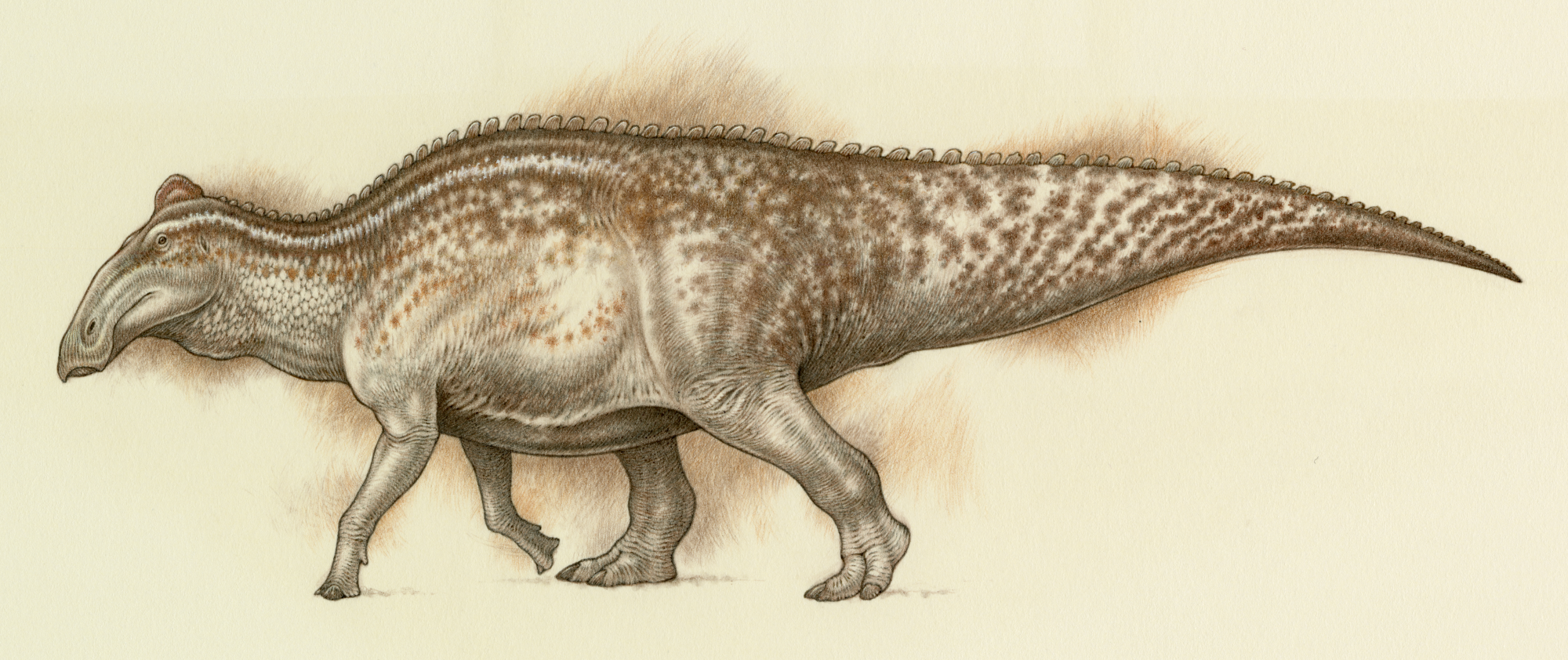


4 Comments
magcargoman
September 25, 2022 at 4:58 pmThe skull is Spiclypeus; a relatively new and obscure Chasmosaurine.
T.K. Sivgin
September 25, 2022 at 6:15 pmIs that really meant to be Gastornis and not a phorusrhacid? Gastornis did not have a hooked beak.
albertonykus
September 25, 2022 at 6:33 pmThat’s a cast of the Berlin Archaeopteryx indeed.
Sophie
September 26, 2022 at 1:26 amThat is one heck of a gift shop toy selection. Little kid me would have burst from excitement. Adult me isn’t much better, really.